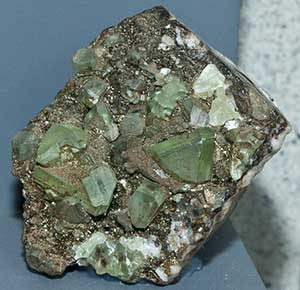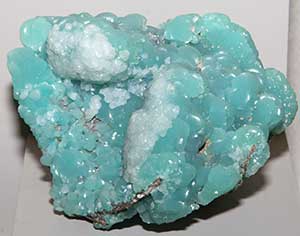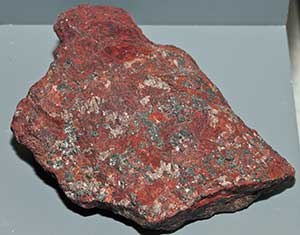 |
| Sphalerite - ZnS. |
 |
| Smithsonite - ZnCO3. |
 |
| Zincite - (Zn,Mn)O. |
Background
In the 1200's, India produced zinc metal by burning organic materials with smithsonite (ZnCO3, zinc carbonate). Zinc was used long before it was known to be a distinct element. Brass items (brass is an alloy, that is, a mixture, of copper and zinc) have been discovered dating back to as early as 1000 B.C. Zinc was isolated and identified as a distinct element in 1746 by the German, Andreas Marggraf.Zinc is a blue-gray, metallic element, with the atomic number 30. At room temperature, zinc is brittle, but it becomes malleable at 100 C. Malleable means it can be bent and shaped without breaking. Zinc is a moderately good conductor of electricity. It is relatively resistant to corrosion in air or water, and therefore is used as a protective layer on iron products to protect them from rusting.
Zinc is recovered from a number of different zinc minerals. The most significant of these is sphalerite (ZnS, zinc sulfide). Other minerals, such as smithsonite (ZnCO3, zinc carbonate), and zincite (ZnO, zinc oxide) are also zinc ores.
Adequate amounts of zinc are essential to a healthy life in all humans and animals. It is necessary for the function of a number of different enzymes. It has also been proved necessary for skin and bone growth as well as sexual maturation. The body uses zinc to process food and nutrients. When animals do not have enough zinc in their systems, they need to consume 50% more food to match the weight gain of an animal with enough zinc in its body. About 0.003% zinc is needed for proper health.
Zinc alloys (mixes) well with other metals resulting in stronger, harder metals. Brass, for example, is a mixture of copper and 20%-45% zinc.
Name
The derivation of zinc is unknown but it comes from the similar German word zinker that is used for the element zink.
Sources
The identified zinc resources worldwide are estimated to total over 1.9 billion tons. In the United States, zinc is mined in several states. Alaska produces the most, followed by Tennessee, and Missouri. Together, these states account for nearly all of the U.S. zinc production. In earlier years zincite deposits in Ogdensburg, New Jersey produced significant quantities of zinc. These mines are now closed but the zinc production of this area is famous among mineralogists.
The United States imports zinc from a number of countries. Of total U.S. zinc imports, the majority comes from Canada, followed by Mexico, from Peru, other countries. Australia is also a significant zinc-producing nation.
Recycling of new scrap, old scrap and other zinc-using products produces about 400,000 tons of zinc in the United States.
Uses
Zinc is relatively non-reactive in air or water. Consequently, it is applied in thin layers to iron and steel products that need to be protected from rusting. This process is called galvanizing. Galvanizing is done in a number of ways. Generally, the metal is dipped in molten zinc. It can also be done by electroplating or by painting on a layer of zinc compound. More than half of the zinc consumed is used for galvanizing.
The second largest use of zinc is as an alloy (other than brass or bronze). Making brass and bronze accounts for another portion of zinc consumption. The remaining zinc consumption is for making paint, chemicals, agricultural applications, in the rubber industry, in TV screens, fluorescent lights and for dry cell batteries. The pennies in your piggy bank are made of zinc - with a thin coating of copper on top.
Substitutes and Alternative Sources
There are a number of alternative materials that are used in place of zinc. For example, aluminum and plastics can be used in place of galvanized steel (plastic trash cans are rapidly replacing the old galvanized cans of earlier generations). A number of elements can replace zinc in its electronics and paint applications. Cadmium and aluminum alloy coatings can be used in place of zinc to protect steel from corrosion.